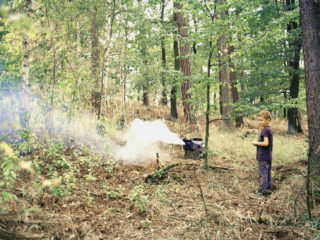Village Romance (2016)
Village Romance is indirectly related to the collection Místo něčeho (The Place of Something). The specific "Place" – the regions surrounding the Bohemian Forest, the artist's home, a cottage – becomes the site of a not-quite-clear but dramatic act. A space which, instead of tourists and the wandering artist, features a dirt road, a fire, feathers and a house on the edge of the village whose new roof shines in the setting sun and contrasts with the crumbling remains of the building. The reference to the transformation of a desolate place into a home (and ultimately pointing to a certain earthing of the artist to one place) is also documented in a video shot from a drone. Two minutes of almost cinematic language tell the story of the author and the site with a certain horror tinge. A drone that attacks the newly found refuge, a piece of land and nature that is not occupied by tourists, but becomes a symbol of external and internal landscapes for the author. A demon that displaces and unsettles everything, ruffling feathers and leaving behind the burning remains of the old part of the house. Against it flickers the figure of a man – the author – who tries to mend the violently separated environments of culture and nature. Through an aerial and partly aggressive raid (and outlook) on the site, he finds a language through which to record the perhaps long-dormant spirits of sacred places, and thus of home. These, like the author, never cease to seek peace, though it is clear that it can never be found: both nature and humans will always be plagued by the elements and demons. The question is whether and if we want to tame them or let them control us.
The title Village Romance paradoxically and with exaggeration describes the harsh reality of reconstruction and the creation of living space. Through the symbolism of child characters, Hrůza also returns to himself and his childhood spent in that region.
In 2016, the video and photographs from the collection were presented in an exhibition at the Jelení Gallery. The works on the walls were complemented by an installation of a drum with a torn feather pillow, referring both to the video but also containing an independent symbolism. The installation indirectly refers to shamanic or other rituals in which the drum as an instrument plays an important role. Tomáš Hrůza also plays this kettledrum in the band Střešovická kramle. In its own specific language, the collection draws on two of Hrůza's favourites: the poet and writer Robinson Jeffers and his unceasing struggle with "inner and outer storms", and the philosopher and ecologist David Abram who considers it most essential to be aware of the complexity, interconnectedness and reciprocity between human beings and the environment in which they live.



